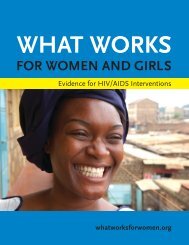Global Tuberculosis Report -- 2012.pdf
Global Tuberculosis Report -- 2012.pdf
Global Tuberculosis Report -- 2012.pdf
You also want an ePaper? Increase the reach of your titles
YUMPU automatically turns print PDFs into web optimized ePapers that Google loves.
cal trial sites and building laboratory and pharmacologyresearch capacity; efforts are coordinated with otherclinical trial networks to optimize efforts to develop newcombination regimens. The Critical Path to New TB DrugRegimens initiative, whose goal is to accelerate the developmentof novel regimens that will shorten TB treatment,is also an important example of a global effort to ensurethat the necessary trials can be implemented. 18.3 New vaccines to prevent TBThe BCG (Bacille-Calmette-Guérin) vaccine for the preventionof TB is almost 100 years old. The vaccine protectsagainst severe forms of TB in children (TB meningitis andmiliary TB), but its efficacy in preventing pulmonary TBin adults is highly variable. BCG is not recommendedfor use in infants known to be infected with HIV, dueto the risk of disseminated BCG disease. Historic opportunitiesfor developing new TB vaccines arose duringthe 1990s, following the development of techniques forgenetic manipulation of mycobacteria and completion ofthe genome sequence of M. tuberculosis.Two different approaches are being used to developTB vaccines for prevention of TB. 2 The first approach isto develop vaccines that would do better than BCG andreplace it – such as an improved version of BCG or anew attenuated live M. tuberculosis vaccine. The secondapproach is to develop a “prime-boost” strategy in whichBCG continues to be given to neonates (as now), since itprevents TB in infants and children, and give the newvaccine as a “booster” dose at a later stage. Alternatively,the new vaccine would be delivered to infants alongsideother vaccines at 3–9 months of age and as a separatebooster in young adults. The vaccine candidates currentlyunder development could be used to prevent either infection(pre-exposure), or to prevent primary progression todisease or reactivation of latent TB (post-exposure). Workis also being carried out to develop vaccines that couldbe used as immunotherapeutic agents, i.e. to improveresponsiveness to chemotherapy.The status of the pipeline for new vaccines in July 2012is shown in Figure 8.3. Of the 12 vaccine candidates inclinical trials, 11 are for prevention of TB and one is animmunotherapeutic vaccine.MVA85A is an attenuated vaccinia-vectored vaccinecandidate designed as a booster vaccine for infants, adolescentsand adults. Among existing vaccine candidatesfor TB prevention, it is the one that is most advanced interms of clinical testing. The first Phase IIb trial of thisvaccine was conducted in South Africa from 2009 to2011, with 2797 infants enrolled. Results are expected inearly 2013, and will provide the first efficacy data of aBOX 8.3Testing the new drug regimen PaMZ(NC-001): progress by mid-2012Novel anti-TB drug regimens could transform therapy byshortening and simplifying the treatment of both drugsensitiveand drug-resistant TB with the same oral regimen.Novel regimens for treatment of MDR-TB have the potential tobe much less expensive than currently recommended therapies(since they include fewer drugs and treatment duration isshorter), fostering expansion of treatment globally.NC-001 – also known as New Combination 1 – is a trial of anovel TB regimen that includes the drug candidate PA-824combined with moxifl oxacin and the standard fi rst-line anti-TB drug, pyrazinamide (PaMZ). The trial is being conductedin partnership with and sponsored by the TB Alliance. Theregimen has been tested for early bactericidal activity againstpulmonary TB over a 2-week period, with encouraging results. 1The regimen had bactericidal activity at least comparableto a standard regimen of isoniazid (H), rifampicin (R),pyrazinamide (Z) and ethambutol (E). This study also validateda new approach to the development of new anti-TB drugregimens, which has the potential to reduce the time requiredto complete clinical trials from decades to years. Research onNC001 has also included testing of some novel combinationsof two drugs that may form the “core” of future regimens, thusinforming other clinical trials being planned during the next 18months and beyond.The testing of the PaMZ regimen advanced to a 2-month trial(called NC-002) in March 2012. In this trial, carried out inBrazil, South Africa and the United Republic of Tanzania, PaMZis being tested for patients with drug-sensitive TB and patientswith drug-resistant TB who are sensitive to the drugs includedin the new regimen. The NC-002 trial is a landmark trial: it isthe fi rst to simultaneously investigate treatment of both drugsensitiveand drug-resistant disease using the same regimen.Results are expected in the third quarter of 2013.1Diacon AH et al. 14-day bactericidal activity of PA-824, bedaquiline,pyrazinamide, and moxifl oxacin combinations: a randomised trial.Lancet, 2012;380(9846):986-93.1http://www.c-path.org/CPTR.cfm2Kaufmann SHE, Hussey G, Lambert PH. New vaccines fortuberculosis. Lancet, 2010, 375:2110–2119.GLOBAL TUBERCULOSIS REPORT 2012 87
















